最新人教版七年级英语上册全册复习
- 格式:ppt
- 大小:1.91 MB
- 文档页数:100
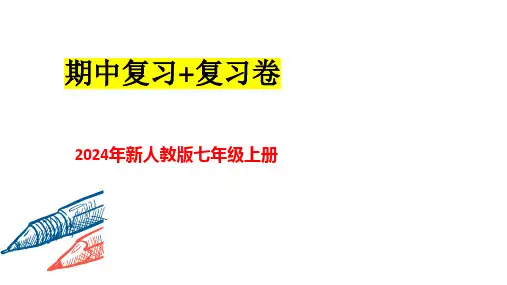
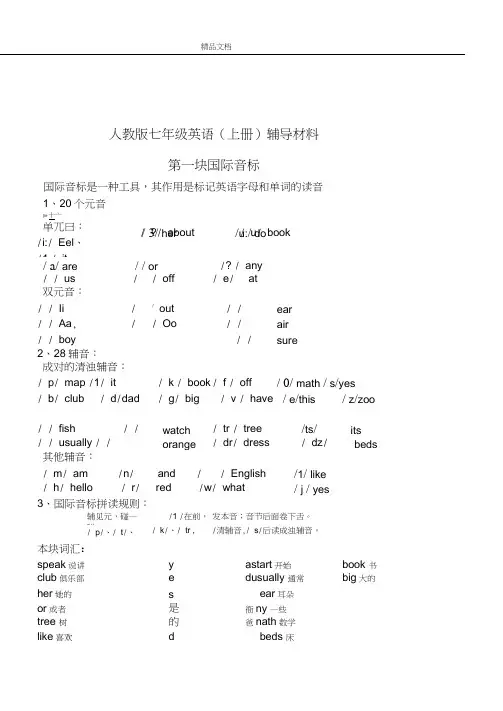
精品文档人教版七年级英语(上册)辅导材料第一块国际音标国际音标是一种工具,其作用是标记英语字母和单词的读音 / a/ are / / or/? / any/ / us / / off/ e / at双元音:/ / Ii / /out / / ear/ / Aa , / / Oo / / air/ / boy/ / sure2、28辅音:成对的清浊辅音:/ p / map /1/ it / k / book / f / off / 0/ math / s /yes / b / club / d /dad / g / big / v / have / e /this / z /zoo/ / fish / / watch / tr / tree /ts /its / / usually / / orange/ dr / dress/ dz /beds其他辅音:/ m / am /n / and / / English /1/ like / h / hello / r / red /w / what/ j / yes3、国际音标拼读规则:辅见元,碰一碰。
/1 /在前, 发本音;音节后面卷下舌。
/ p /、/ t /、/ k /、/ tr ,/清辅音,/ s /后读成浊辅音。
本块词汇:speak 说讲 y astart 开始 book 书 club 俱乐部 e dusually 通常 big 大的her 她的 s ear 耳朵 or 或者 是 衙ny —些tree 树 的 爸nath 数学like 喜欢dbeds 床/ ?/ about / u / book 1、20个元音|Vr十亠单兀曰: /i:/ Eel 、 /1 / it / 3/ her /u:/ do精品文档精品文档PDF文件使用"pdfFactory Pro"试用版本创建精品文档第二块三个预备单元一、文化常识1、英语文化区域,熟人之间见面,常要互相问好。
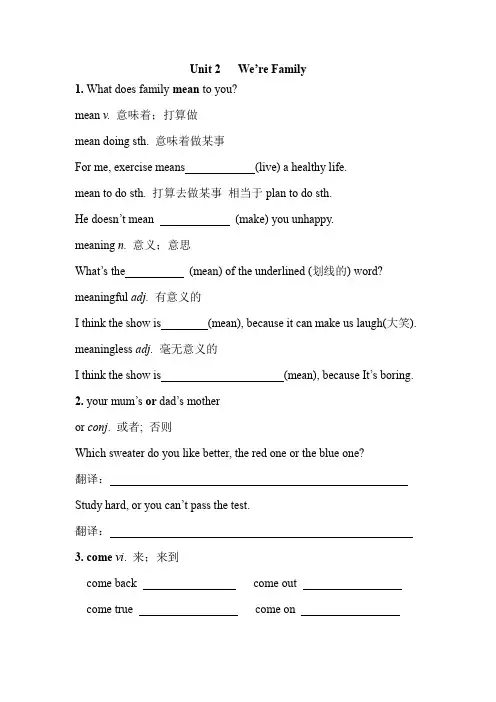
Unit 2 We’re Family1. What does family mean to you?mean v.意味着;打算做mean doing sth. 意味着做某事For me, exercise means (live) a healthy life.mean to do sth. 打算去做某事相当于plan to do sth.He doesn’t mean (make) you unhappy.meaning n.意义;意思What’s the (mean) of the underlined (划线的) word? meaningful adj. 有意义的I think the show is (mean), because it can make us laugh(大笑). meaningless adj. 毫无意义的I think the show is (mean), because It’s boring.2. your mum’s or dad’s motheror conj. 或者; 否则Which sweater do you like better, the red one or the blue one?翻译:Study hard, or you can’t pass the test.翻译:e vi. 来;来到come back come outcome true come onThe book (出版) in the 1930s.I believe (相信) I can make my dream(梦想) (实现).4.Whose are they? whose 谁的Whose shirt is it?Whose books are they?Whose+ n.+一般疑问句?---is your English teacher?---The beautiful woman over there.A. WhoseB. WhoC. WhatD. Why---books are over there?---They are Teng Fei’s.A. WhoseB. WhoC. WhatD. Why5. Do you often play ping-pong together?together adv. 共同;一起Chinese go back home to eat dinner together during the Spring Festival.翻译:all together 总共get together 集合pull together 齐心协力6. Whose fishing rods are those?fishing rod 动名词作定语,修饰名词walking stick swimming poolreading/living room eating habitwaiting time waiting room7.He spend a lot of/lots of time fishing.spend time/money on sth. 在某事/某物上花费时间或钱。
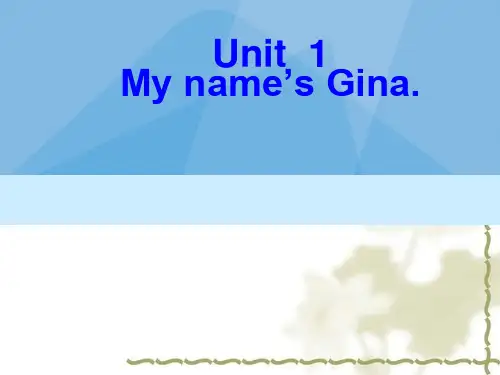
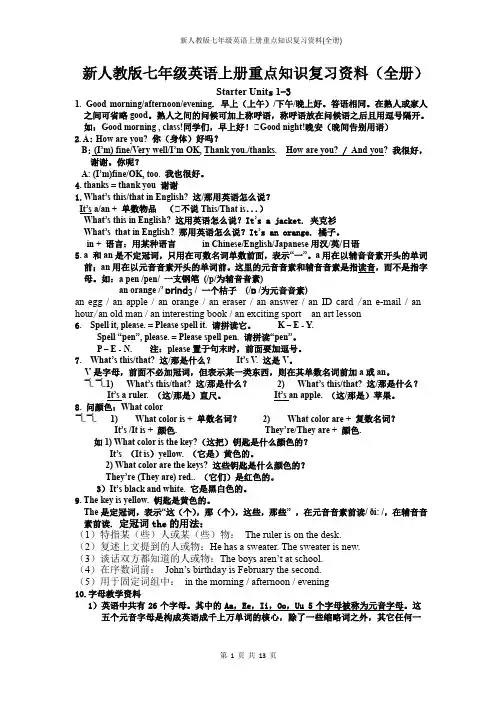
新人教版七年级英语上册重点知识复习资料(全册)Starter Unit s 1-31.Good morning/afternoon/evening. 早上(上午)/下午/晚上好。
答语相同。
在熟人或家人之间可省略good。
熟人之间的问候可加上称呼语,称呼语放在问候语之后且用逗号隔开。
如:Good morning , class!同学们,早上好!△Good night!晚安(晚间告别用语)2. A: How are you? 你(身体)好吗?B: (I’m) fine/Very well/I’m OK, Thank you./thanks.How are you? / And you?我很好,谢谢。
你呢?A: (I’m)fine/OK, too.我也很好。
4. thanks = thank you 谢谢1.What’s this/that in English? 这/那用英语怎么说?It’s a/an + 单数物品(△不说This/That is...)What’s this in English? 这用英语怎么说?It’s a jacket. 夹克衫What’s that in English?那用英语怎么说?It’s an orange. 橘子。
in + 语言:用某种语言in Chinese/English/Japanese用汉/英/日语5. a 和an是不定冠词,只用在可数名词单数前面,表示“一”。
a用在以辅音音素开头的单词前;an用在以元音音素开头的单词前。
这里的元音音素和辅音音素是指读音,而不是指字母。
如:a pen /pen/ 一支钢笔(/p/为辅音音素)an orange /’ ɒrindʒ / 一个桔子(/ɒ /为元音音素)an egg / an apple / an orange / an eraser / an answer / an ID card /an e-mail / an hour/an old man / an interesting book / an exciting sport an art lesson6. Spell it, please. = Please spell it. 请拼读它。
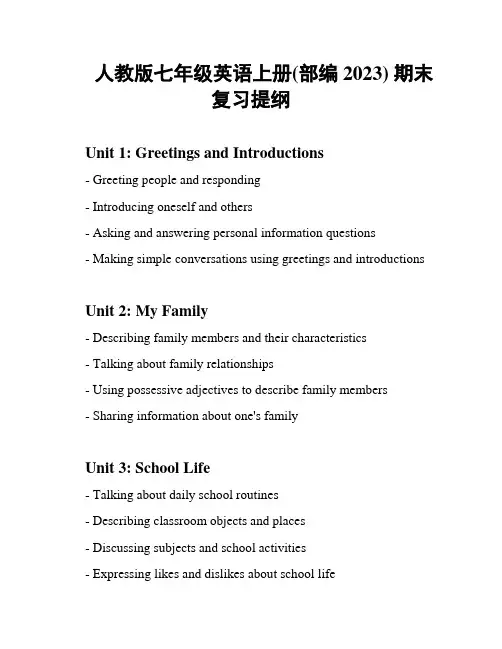
人教版七年级英语上册(部编2023) 期末复习提纲Unit 1: Greetings and Introductions- Greeting people and responding- Introducing oneself and others- Asking and answering personal information questions- Making simple conversations using greetings and introductionsUnit 2: My Family- Describing family members and their characteristics- Talking about family relationships- Using possessive adjectives to describe family members- Sharing information about one's familyUnit 3: School Life- Talking about daily school routines- Describing classroom objects and places- Discussing subjects and school activities- Expressing likes and dislikes about school lifeUnit 4: Hobbies and Interests- Talking about hobbies and interests- Describing activities related to hobbies- Expressing preferences and opinions about hobbiesUnit 5: Food and Drinks- Describing food and drinks- Talking about likes and dislikes of food- Ordering food and drinks at a restaurant- Expressing preferences for different types of foodUnit 6: Colors and Clothes- Learning different colors in English- Describing clothes and their colors- Talking about clothing preferences and styles- Discussing appropriate clothing for different occasionsUnit 7: Numbers and Telling Time- Learning and pronouncing numbers in English- Talking about dates and birthdays- Telling time and discussing daily schedules- Expressing time using both analog and digital formatsUnit 8: Daily Activities- Discussing daily activities and routines- Talking about leisure activities and free time- Using time expressions to describe daily routinesUnit 9: Places in the City- Describing different places in a city- Giving directions to navigate through a city- Talking about likes and dislikes of places- Discussing activities to do in different locationsUnit 10: Occupations and Aspirations- Learning and pronouncing different occupations- Talking about future aspirations and dreams- Describing job responsibilities and characteristics- Discussing personal interests related to future careersUnit 11: Weather and Seasons- Describing different weather conditions- Talking about seasons and their characteristics- Discussing favorite seasons and weather preferences- Expressing feelings and emotions about the weatherUnit 12: Holidays and Celebrations- Learning about different holidays and celebrations- Describing traditions and customs of specific holidays - Talking about personal experiences during holidays- Expressing wishes and greetings for different occasionsUnit 13: Daily Routines- Talking about daily activities and schedules- Using adverbs of frequency to describe routines- Discussing preferences for different activities- Expressing opinions about daily routinesUnit 14: Health and Body- Describing body parts and their functions- Discussing healthy habits and lifestyle choices- Giving advice for maintaining good healthUnit 15: Shopping- Talking about different types of shops and stores- Describing items for sale and their prices- Discussing shopping preferences and habits- Asking for help and making purchases at a storeUnit 16: Transportation- Learning and pronouncing different modes of transportation - Talking about means of transportation and their features- Describing travel experiences and preferences- Asking for transportation information and directionsUnit 17: Countries and Nationalities- Learning and pronouncing different countries and nationalities - Talking about one's own and others' nationalities- Discussing cultural characteristics and traditionsUnit 18: Daily Life in Different Countries- Learning about daily life customs in different countries- Talking about cultural differences and similarities- Discussing traditional food, clothing, and activities- Sharing personal experiences or knowledge about other countries- Talking about different types of technology and devices- Describing how technology is used in daily life- Discussing advantages and disadvantages of technology- Expressing opinions about technology and social mediaUnit 20: Review and Assessment- Reviewing key vocabulary and grammar points from previous units- Practicing listening, speaking, reading, and writing skills请根据这个提纲来复习人教版七年级英语上册的内容。
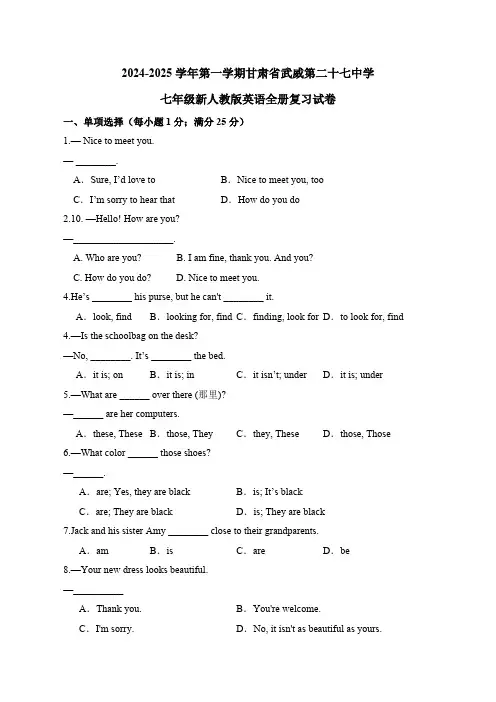
2024-2025学年第一学期甘肃省武威第二十七中学七年级新人教版英语全册复习试卷一、单项选择(每小题1分;满分25分)1.— Nice to meet you.— ________.A.Sure, I’d love to B.Nice to meet you, tooC.I’m sorry to hear that D.How do you do2.10. —Hello! How are you?—____________________.A. Who are you?B. I am fine, thank you. And you?C. How do you do?D. Nice to meet you.4.He’s ________ his purse, but he can't ________ it.A.look, find B.looking for, find C.finding, look for D.to look for, find 4.—Is the schoolbag on the desk?—No, ________. It’s ________ the bed.A.it is; on B.it is; in C.it isn’t; under D.it is; under 5.—What are ______ over there (那里)?—______ are her computers.A.these, These B.those, They C.they, These D.those, Those 6.—What color ______ those shoes?—______.A.are; Yes, they are black B.is; It’s blackC.are; They are black D.is; They are black7.Jack and his sister Amy ________ close to their grandparents.A.am B.is C.are D.be 8.—Your new dress looks beautiful.—__________A.Thank you.B.You're welcome.C.I'm sorry.D.No, it isn't as beautiful as yours.9.My brother can play ________ guitar and Jack can play ________ basketball.A.a;the B.the;a C./;the D.the;/10.— My name is Mike Smith and my friend’s name is Mike Black.— Ha-ha! You have the same ________ name.A.first B.second C.last D.family11.Your mother’s brother is your ____.A. auntB. uncleC. brotherD. grandfather12.Let’s ________. I need to buy something for the party.A.have lessons B.play sports C.have a cold D.go shopping14.Lily _________ playing football, but she doesn’t _________ playing tennis. A.likes; likes B.like; likeC.likes; like D.like; likes14.—________ there any banks near here?—No, but there ________ a bank on Center Street.A.Are; is B.Is; are C.Does; is D.Are; are15.The chicken hamburger is ________. I like it very much.A.difficult B.relaxing C.delicious D.interesting 16.Most students spend too much time ________ computer games.A.playing B.playC.plays D.played17.I don’t like watching this TV show. It’s ________.A.boring B.funny C.interesting D.different18.I like English ________ Chinese. I think they’re difficult ________ interesting.A.and; and B.and; but C.but; and D.but; but 19.—What’s the ________ of your room?—It’s Room 209.A.colour B.time C.number D.money 20.—What can I do to improve my ________ of English writing?—You can read some famous English novels.A.Pronunciation B.mistake C.ability D.secret21.—There are so many scarves. Which one do you want to _________?—I like the red one.A.make B.choose C.share D.save22.I am ________ in reading different kinds of ________ books.A.interested; interested B.interesting; interestingC.interested; interesting D.interesting; interested24.On Mother’s Day, I often ________ a special gift for my mother.A.prepare B.eat C.help D.raise24.I have _________ finished my homework. I finished it an hour ago.A.yet B.ever C.never D.already25.—Why not hold a Chinese Poetry Competition to welcome our school’s 90th birthday?—________.A.That’s all right B.Yes, pleaseC.Good idea D.Never mind二、完形填空(每小题1分;满分15分)阅读短文,掌握其大意,然后从各小题所给的四个选项中,选出一个最佳答案。
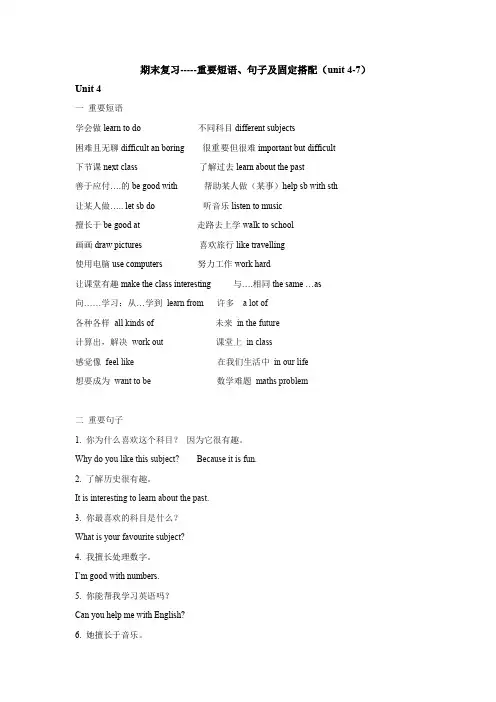
期末复习-----重要短语、句子及固定搭配(unit 4-7)Unit 4一重要短语学会做learn to do 不同科目different subjects困难且无聊difficult an boring 很重要但很难important but difficult下节课next class 了解过去learn about the past善于应付….的be good with 帮助某人做(某事)help sb with sth让某人做….. let sb do 听音乐listen to music擅长于be good at 走路去上学walk to school画画draw pictures 喜欢旅行like travelling使用电脑use computers 努力工作work hard让课堂有趣make the class interesting 与….相同the same …as向……学习:从…学到learn from 许多 a lot of各种各样all kinds of 未来in the future计算出,解决work out 课堂上in class感觉像feel like 在我们生活中in our life想要成为want to be 数学难题maths problem二重要句子1. 你为什么喜欢这个科目?因为它很有趣。
Why do you like this subject? Because it is fun.2. 了解历史很有趣。
It is interesting to learn about the past.3. 你最喜欢的科目是什么?What is your favourite subject?4. 我擅长处理数字。
I’m good with numbers.5. 你能帮我学习英语吗?Can you help me with English?6. 她擅长于音乐。
I am good with music.7. 学习使用电脑很有趣.It is fun to learn to use computer.8. 有时记住所有的信息很困难。
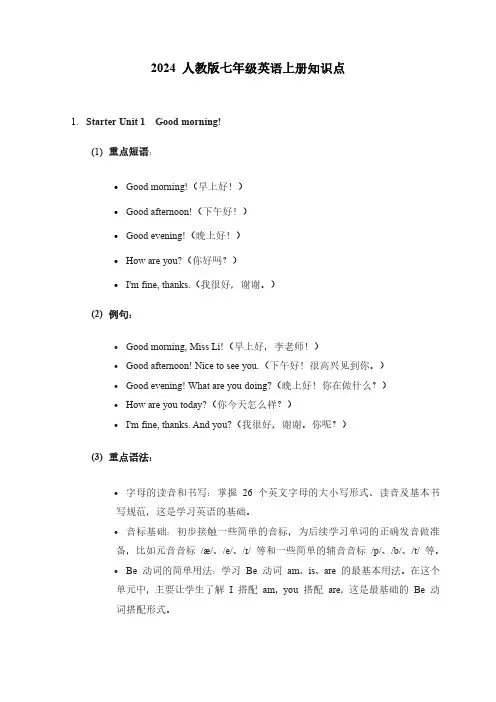
2024人教版七年级英语上册知识点1.Starter Unit1Good morning!(1)重点短语:∙Good morning!(早上好!)∙Good afternoon!(下午好!)∙Good evening!(晚上好!)∙How are you?(你好吗?)∙I'm fine,thanks.(我很好,谢谢。
)(2)例句:∙Good morning,Miss Li!(早上好,李老师!)∙Good afternoon!Nice to see you.(下午好!很高兴见到你。
)∙Good evening!What are you doing?(晚上好!你在做什么?)∙How are you today?(你今天怎么样?)∙I'm fine,thanks.And you?(我很好,谢谢。
你呢?)(3)重点语法:∙字母的读音和书写:掌握26个英文字母的大小写形式、读音及基本书写规范,这是学习英语的基础。
∙音标基础:初步接触一些简单的音标,为后续学习单词的正确发音做准备,比如元音音标/æ/、/e/、/ɪ/等和一些简单的辅音音标/p/、/b/、/t/等。
∙Be动词的简单用法:学习Be动词am、is、are的最基本用法。
在这个单元中,主要让学生了解I搭配am,you搭配are,这是最基础的Be动词搭配形式。
2.Starter Unit2What's this in English?:(1)重点单词:map(地图)cup(杯子)ruler(尺子)pen(钢笔)orange(橙子)jacket(夹克衫)key(钥匙)quilt(被子)what(什么)in(在……里)English(英语;英文)。
(2)重点短语:∙询问物品:What's this in English?(这个用英语怎么说?)、What's that inEnglish?(那个用英语怎么说?)∙回答方式:It's a/an...(它是一个……)。
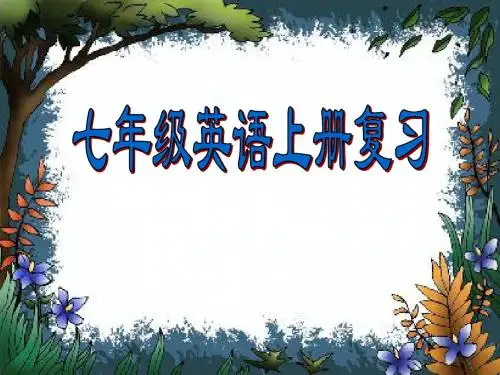

新人教版七年级上册英语重难点突破知识点梳理及重点题型巩固练习Starter units1-3词句精讲精练词汇精讲1. hello&hihello “你好”,是朋友、亲人或者熟人之间非正式的问候语,可以用来表示问候、打招呼或引起对方注意,回答时用hello或hi均可。
hi 和hello一样也是“你好”的意思,在美国用的非常普遍,不仅用于熟人之间,也用于陌生人之间,比hello更简洁和随便,尤其用于擦肩而过的打招呼。
例如:-Hello/Hi, Bob! 你好, 鲍勃!-Hello/Hi, John. 你好,约翰。
注意:(1)打电话时一般用hello而不用hi。
例如:Hello, this is Mary. 喂,我是玛丽。
(2)当引起人们注意时,两者都可以。
例如:Hello/Hi, is anyone there? 喂,那儿有人吗?(3)对老师、上级、年长者以及有身份地位的人打招呼时,一般不用hello和hi,以免对其显得不尊重。
此时要根据具体的场合选择不同的正式的问候语。
例如:Good morning, Miss Wang. 早上好,王老师。
(4)在初次介绍朋友时,人们还是愿意使用比较正式的问候语。
例如:How do you do? 你好。
Nice to meet you. 很高兴见到你。
2. thanks“Thanks.”相当于“Thank you.”,在英美等国家是使用频率最高的礼貌用语。
当别人帮助、关心、问候、祝福我们时,应使用“Thank you/Thanks”应答,表示谢意。
由于文化的差异,当得到对方的称赞、夸奖时,英美人也用“Thank you./Thanks.”来应答,以示礼貌。
这点与我们中国人不同。
例如:-You look nice in this skirt. 你穿这件裙子看起来很漂亮。
-Thanks. / Thank you. 谢谢!3. please“please”意为“请”。
词Ⅰ. 词的分类1.名词noun:表示人或事物的名称2.冠词article:用在名词前帮助说明名词所指的人或事物3.代词pronoun:用来代替名词、形容词或数词4.动词verb:表示动作或状态5.副词adverb:修饰动词、形容词或其他副词6.介词preposition:表示名词代词等和句中其他词的关系7.连词conjunction:用来连接词与词、短语与短语或句与句8.感叹词interjection:表示说话时的喜悦、惊讶等感情Ⅱ. 名词(Nouns)1. 名词的分类:可数名词(有复数形式)、不可数名词(没有复数形式)2. 名词复数的构成(1)规则变化1)在其后加-s2)以-s,-x,-ch,-sh 结尾加-es3)大部分以o结尾的名词后加-es (有生命力,则该词汇一般加-es, 如tomato,potato;没生命力的加-s)4)以“辅音字母+y”结尾的名词把“y”变成“i”,再加-es5)以-f(e)结尾的knife,把fe变v再加es(2.)不规则变化1)child---children foot---feet tooth---teethmouse---mice man---men woman---women(3)单复同形如:deer,sheep,fish,Chinese,Japanese(4)表示由两部分构成的东西,如:glasses (眼镜)trousers,若表达具体数目,要借助数量词pair(对,双);suit(套);例如a pair of glasses; two pairs of trousers3. 名词的所有格(1). 名词所有格的形式词尾加‘s构成以of连接(2). 名词所有格的构成方式1)单数名词+’se.g. 迈克的爸爸Mike’s father2) 以-s结尾的复数名词仅加‘,但是不规则复数名词仍要加’se.g. 老师们的房间teachers’room孩子们的篮球children’s basketball3)几个词作为一个单位时,’s应加在最后一个词的末尾e.g. Lily and Lucy’s room 莉莉和露西的房间区分:Lily and Lucy’s room 莉莉和露西共用的房间Lily and Lucy’s room 莉莉的房间和露西的房间4. 名词作定语名词作定语没有复数形式e.g. Pencil case ------------- four pencil casesshoe factory ----------- five shoe factories但是以man, woman修饰的名词变复数除外,例如:a man doctor ---------------- three men doctorsa woman teacher -------------- ten women teachersⅢ. 代词(Pronouns)1. 代词的分类人称代词(Personal Pronouns)物主代词(Possessive Pronouns)形容词性物主代词名词性物主代词指示代词(Demonstrative Pronouns)2. 人称代词1)2)人称代词有主格和宾格之分。
2023-2024学年人教版七年级英语上册期末语法知识总复习(一)名词复数变化规则1.一般情况下直接加s:book books orange oranges2.以s.x,ch,sh结尾加-es:dresses、boxes、brushes、watches、3.以辅音字母加y结尾变y为i加-es:family、dictionary、library strawberry、activity、country baby、party、butterfly、city story4.以f/fe结尾变f,fe为v再加-es:knife-knives leaf-leaves wife-wives life-lives5.以o结尾,表示有生命的事物的单数名词加-es: 黑人(Negro)英雄(hero)爱在火山(volcano)吃土豆(potato)西红柿(tomato)以o结尾,表示没有生命的事物的单数名词加-s:photo-photos zoo-zoos radio-radios名词复数不规则变化1.变内部元音: man-men woman-women foot-feet tooth-teeth2.特殊变化:child-children mouse-mice3.单复数同行:deer sheep Chinese fish(鱼的数量) clothes people glasses(二)名词所有格变化规则1.单数名词后加-’s:Amy’s room 艾米的房间2.以s结尾的复数名词后加-’:Teachers’ Day教师节the students’ books学生们的课本3.不以s结尾的复数名词后加-’:Women's Day妇女节Children's Day 儿童节4.某物为几个人共有最后面的名词加-'s: Lucy and Lily's desk 露西和莉莉(共有)的课桌5.几个人各自拥有的东西几个名词后都加-'s: Lucy's and Lily's bikes 露西和莉莉(各自)的自行车6.表示店铺或某人的家后加-’s或-’(所修饰的名词常被省略)at the Tom's (home)在汤姆家at the Greens' (home)在格林家7.没有生命的东西:名词十of十名词:the window of the classroom教室的窗户(三) 不定冠词a/an:①相当于数量词“one",但语气不如“one”强烈。
人教版七年级英语上册复习大全Starter unit 11. 短语归纳good morning早上好name list名单good afternoon下午好an English name英文名字good evening晚上好2. 必背典句Good morning!早上好!Good afternoon!下午好!Good evening晚上好3.英语中常见的问候语(1)Hello! “你好!〞是比拟随便、不分时间的一种问候语,通常用于打招呼、打。
表示惊讶或引起对方注意。
对方应答仍用Hello!(2)Hi! “你好!〞的使用比 hello!更随便,在年轻人中使用更为普遍。
(3)Nice to meet you! “很快乐见到你!〞是两个初次见面、经介绍相识的人互相打招呼的用于。
答复时可以说 Nice to meet you, too. 或者 Me, too. 来表示“见到你很快乐〞(4)How do you do? “你好!〞用于初次见面,是非正式的打招呼用语。
对方应答语应是“How do you do?〞(5)How are you? 意为“你好吗?〞,为询问对方身体状况的问候语。
应答语一般是“I ’m fineThank. you. / I ’m very well/.Thank you. / I m ’OK.〞。
How are you? 的其他用法:习惯上答复完别人的问候后,常可反问对方的身体状况,此时可用How are you? 也可用And you?“你呢?〞4.大写字母的用法(1) 在英语中,句子的第一个单词的第一个字母都应大写。
Sit down, please. 请坐。
(2) 字母 I 作人称代词时,意为“我〞,在句中任何位置都必须大写。
日常用语“OK〞在句中任何位置都大写。
I ’m a student.我是一名学生。
Is everything OK? 一切都好吗?(3) 人名、地名、国名、某国人或某种语言等专有名词的第一个字母都必须大写。
(人教版) 2024七年级上册Unit 4 知识点梳理Section A1a 掌握不同学科的表达拓展:1.history 历史a long history 悠久的历史in history 历史上2.English (国家) England1c 拓展1.hard =difficult (反义词) easy2.fun名词have fun doing sth. 玩得开心........eful 有用的a useful book (u字母的发音为辅音音素)4.exciting 令人兴奋的(用于说明事物) It’s ______________(令人兴奋的电影)excited 兴奋的(用于说明人) I’m ____________(兴奋的听到) the good news.5.boring 令人兴奋的(用于说明事物) It’s ______________(令人乏味的电影)bored 兴奋的(用于说明人) The trip makes me____________(觉得无聊)Pronunciation1 策略:双元音是作为一个音节,用一次呼气发出来的两个元音的连缀。
双元音的两个成分中只有第一个读得比较重,长和清晰,第二个则要读得比较轻、短和含糊。
2.wake him up 唤醒他You're going to __________(迟到).2a 1.What's our ____________(下节课)?2.It's __________(interest) to learn about the past.(了解过去)3.past ①[名词] 过去;过去的事情in the past 在过去②[形容词] 过去的in past years 在过去的岁月③[介词]晚于; 在...…之后half past two 2点半4. It's useful, and my English teacher is _________(real) nice.5.I like all the subjects, ________ my favourite is maths.6.I'm good ____________ numbers. 我擅长和数字打交道。
人教版(2024)英语七年级上册期末复习1. Playing chess and listening to music are my ________ (hobby).2. I don’t like the colour of the sweater. Please show me ________ (other) one.3. Mrs. Smith makes nice food for her three ________ (grandchild) every day.4. The students in our school do morning ________ (exercise) every day.5. The tall ________ (build) next to the Green Park is a library.6. The little boy can play tennis so well. How ________ (amaze)!7. My schoolbag and some other things are in these ________ (lock).8. The idea of going fishing this Saturday ________ (sound) interesting.9. We often spend ten minutes ________ (change) our seats every Monday morning.10. The ________ (fun) stories in the book make us laugh a lot.11. Jenny g________ me by saying “Hello” every morning.12. Michael is from a different c________—Australia.13. The little boy is clever and can c________ from 1 to 100.14. Here are some middle school students. E________ of them has a schoolbag.15. You can see a book, a ruler, a hat and other t________ in the picture.16. In our school library, you can see many b________ with lots of books.17. There is a nice picture on the s________ of the computer.18. The colours of the two coats are d________. This one is blue and the other one is green.19. The teacher often uses the s________ whiteboard to give lessons.20. The fish here is d________. Would you like some?用方框中所给单词的适当形式填空。